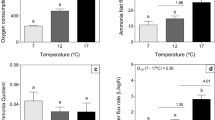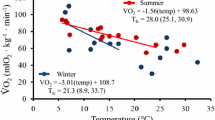Summary
The emu is a large flightless bird (body mass, BM, about 40 kg), whose range extends into the arid regions of Australia. Its water relations were studied by examining the water turnover and the distribution of body water before and after 9 days of water restriction, when only dry feed was provided. Initially water turnover was 44.8 ml kg−1 d−1 but with restriction of intake water balance was not maintained. Although efflux was reduced to 14.8 ml kg−1 d−1 the net water loss was still about 7 ml kg−1 d−1.
Total body water was 61% of body mass (ml H2O/100 gBM) in both hydrated and dehydrated emus. The initial distribution of water was: plasma volume 5.0% BM, interstitial volume 39.1% BM. Gut water content was 7.6% BM in wild emus. During dehydration the interstitial space lost the most water, contributing 54.5% of the total loss compared with 36.4% from cells and gut. Calculations indicate that the emu can remain in water balance without drinking only if its food has a high water content and water is not required for thermoregulation.
Similar content being viewed by others
References
Calder WA III, Dawson TJ (1978) Resting metabolic rates of ratite birds: the kiwis and the emu. Comp Biochem Physiol 60A:479–481
Davies SJJF (1978) The food of emus. Aust J Ecol 3:411–422
Davies SJJF (1982) Behavioural adaptations of birds to environments where evaporttion is high and water is in short supply. Comp Biochem Physiol 71A:557–566
Dawson TJ, Herd RM (1983) Digestion in the emu;Dromaius novaehollandiae: low energy and nitrogen requirements in this large ratite bird. Comp Biochem Physiol 75A:41–45
Degen AA, Pinshow B, Alkon PV (1982) Water flux in chukar partridges (Alectoris chukar) and a comparison with other birds. Physiol Zool 55:64–71
Denny MJS, Dawson TJ (1975) Effects of dehydration on bodywater distribution in desert kangaroos. Am J Physiol 229:251–254
Herd RM, Dawson TJ (1983) Fibre digestion in the emu (Dromaius novaehollandiae), a large bird with a simple gut and high rates of passage. Physiol Zool (in press)
Jones DR, Johansen K (1972) The blood vascular system of birds. In: Farner DS, King JA (eds) Avian biology, vol II. Academic Press, New York London, pp 157–285
Louw GN (1972) The role of advective fog in the water economy of certain Namib desert aiimals. Symp Zool Soc Lond 31:297–314
MacFarlane WV (1964) Terrestrial animals in dry heat: ungulates. In: Handbook of physiology. Adaptation to the environment. Washington, DC. Am Physiol Soc, pp 509–539
MacFarlane WV, Howard B (1972) Comparative water and energy economy of wild and domestic animals. Symp Zool Soc Lond 31:261–296
Nagy KA, Costa DP (1980) Water flux in animals: analysis of potential errors in the tritiated water method. Am J Physiol 238:R454-R465
Nicol SC (1978) Rates of water turnover in marsupials and eutherians: A comparative review with new data on theTasmanian devil. Aust J Zool 26:465–473
Richmond CR, Langham WH, Trujillo TT (1962) Comparative metabolism of tritiated water by mammals. J Cell Comp Physiol 59:45–53
Schmidt-Nielsen K (1964) Desert animals: Physiological problems of heat and water. Oxford University Press, New York
Schmidt-Nielsen K (1979) Animal physiology: Adaptation and environment. Cambridge University Press, Cambridge
Skadhauge E (1974) Renal concentrating ability in selected West Australian birds. J Exp Physiol 61:269–276
Skadhauge E (1981) Osmoregulation in Birds. Springer, Berlin Heidelberg New York
Taylor CR (1968) The minimum water requirements of some East African bovids. Symp Zool Soc Lond 21:195–206
Vaughan BE, Bolling EA (1961) Rapid assay procedures for tritium-labelled water in body fluids. J Lab Clin Med 57:159–164
Author information
Authors and Affiliations
Rights and permissions
About this article
Cite this article
Dawson, T.J., Herd, R.M. & Skadhauge, E. Water turnover and body water distribution during dehydration in a large arid-zone bird, the Emu,Dromaius novaehollandiae . J Comp Physiol B 153, 235–240 (1983). https://doi.org/10.1007/BF00689626
Accepted:
Issue Date:
DOI: https://doi.org/10.1007/BF00689626




